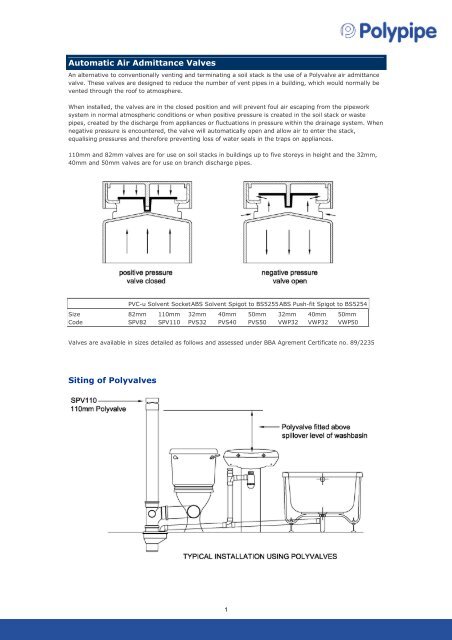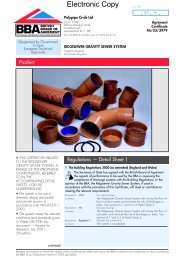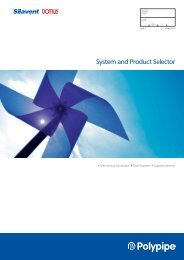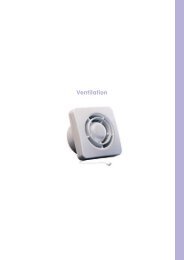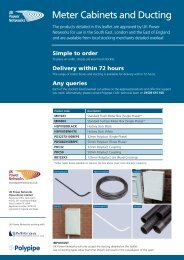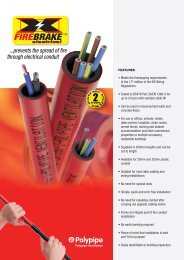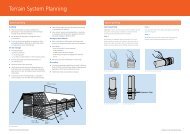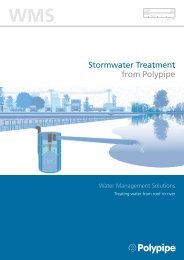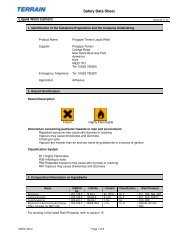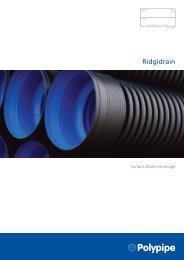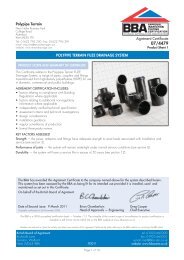Siting of Polyvalves Automatic Air Admittance Valves - Polypipe
Siting of Polyvalves Automatic Air Admittance Valves - Polypipe
Siting of Polyvalves Automatic Air Admittance Valves - Polypipe
Create successful ePaper yourself
Turn your PDF publications into a flip-book with our unique Google optimized e-Paper software.
<strong>Automatic</strong> <strong>Air</strong> <strong>Admittance</strong> <strong>Valves</strong><br />
An alternative to conventionally venting and terminating a soil stack is the use <strong>of</strong> a Polyvalve air admittance<br />
valve. These valves are designed to reduce the number <strong>of</strong> vent pipes in a building, which would normally be<br />
vented through the ro<strong>of</strong> to atmosphere.<br />
When installed, the valves are in the closed position and will prevent foul air escaping from the pipework<br />
system in normal atmospheric conditions or when positive pressure is created in the soil stack or waste<br />
pipes, created by the discharge from appliances or fluctuations in pressure within the drainage system. When<br />
negative pressure is encountered, the valve will automatically open and allow air to enter the stack,<br />
equalising pressures and therefore preventing loss <strong>of</strong> water seals in the traps on appliances.<br />
110mm and 82mm valves are for use on soil stacks in buildings up to five storeys in height and the 32mm,<br />
40mm and 50mm valves are for use on branch discharge pipes.<br />
PVC-u Solvent SocketABS Solvent Spigot to BS5255 ABS Push-fit Spigot to BS5254<br />
Size 82mm 110mm 32mm 40mm 50mm 32mm 40mm 50mm<br />
Code SPV82 SPV110 PVS32 PVS40 PVS50 VWP32 VWP32 VWP50<br />
<strong>Valves</strong> are available in sizes detailed as follows and assessed under BBA Agrement Certificate no. 89/2235<br />
<strong>Siting</strong> <strong>of</strong> <strong>Polyvalves</strong><br />
1
1. 82mm and 110mm <strong>Polyvalves</strong> should be fixed above the spillover level <strong>of</strong> the highest appliance draining<br />
into the soil stack. There is no specified minimum dimension for the fixing height above this level.<br />
2. <strong>Valves</strong> should be fitted in a vertical position.<br />
3. It is not permitted for valves to be fitted externally. They should be sited internally, preferably in a freely<br />
ventilated, non-habitable space such as a duct or ro<strong>of</strong> space where there is no risk <strong>of</strong> freezing and where<br />
they are easily accessible but not likely to be subject to interference, e.g. from vandals. Where the valve is<br />
installed in a duct, holes should be provided allow an air supply to the valve.<br />
4. A Polyvalve should not be used on a stack that provides the only means <strong>of</strong> ventilation to a septic tank or<br />
cess pool.<br />
5. <strong>Polyvalves</strong> are supplied with an expanded polystyrene insulative shroud. The shroud should be left in<br />
position on the valve when it is being fitted in a location where there is a possibility <strong>of</strong> condensation forming<br />
within the valve e.g. unheated ro<strong>of</strong> space.<br />
6. To prevent induced siphonage in a row <strong>of</strong> washbasins, a 40mm or 50mm Polyvalve should be fitted<br />
between the two washbasins furthest from the stack.<br />
7. In all installations, stacks should not be fitted with air admittance valves where the connecting drain(s)<br />
are subject to periodic surcharging or are fitted with intercepting traps. In this case a conventionally vented<br />
stack should be used.<br />
8. It is recommended that all <strong>Polyvalves</strong> are tested for airtightness before installation, i.e. the valves should<br />
float when supported in an upright position in a bowl <strong>of</strong> water.<br />
2
Drain Ventilation Provision<br />
Installation <strong>of</strong> 20 Dwellings<br />
1. For up to and including four dwellings, one, two or three storeys in height, additional drain venting is not<br />
required.<br />
2. For five to 10 dwellings, a conventional vent stack should be provided at the head <strong>of</strong> the drain run.<br />
3. For eleven to 20 dwellings, a conventional vent stack should be provided at the mid-point and head <strong>of</strong> the<br />
drain run.<br />
4. For multi-storey domestic dwellings (other than those referred to above) and non domestic buildings,<br />
conventional drain venting should be provided if more than one such building, each equipped with the valves,<br />
is connected to either a common drain, itself not vented by means <strong>of</strong> a ventilation stack, or to a discharge<br />
stack not fitted with a valve.<br />
6


